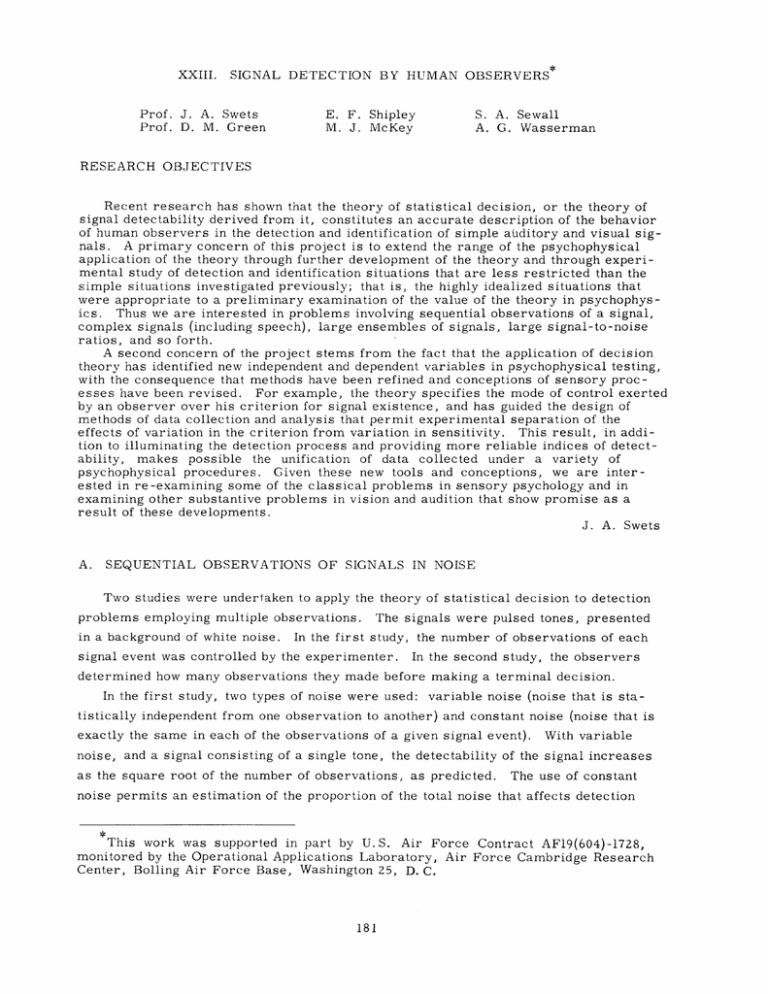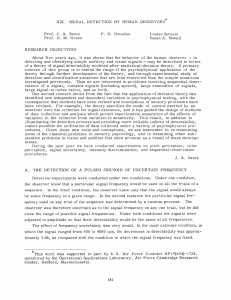XXIII. SIGNAL DETECTION BY HUMAN OBSERVERS*
advertisement

XXIII. SIGNAL DETECTION BY HUMAN OBSERVERS* Prof. J. A. Swets Prof. D. M. Green E. F. M. J. Shipley McKey S. A. Sewall A. G. Wasserman RESEARCH OBJECTIVES Recent research has shown that the theory of statistical decision, or the theory of signal detectability derived from it, constitutes an accurate description of the behavior of human observers in the detection and identification of simple auditory and visual signals. A primary concern of this project is to extend the range of the psychophysical application of the theory through further development of the theory and through experimental study of detection and identification situations that are less restricted than the simple situations investigated previously; that is, the highly idealized situations that were appropriate to a preliminary examination of the value of the theory in psychophysics. Thus we are interested in problems involving sequential observations of a signal, complex signals (including speech), large ensembles of signals, large signal-to-noise ratios, and so forth. A second concern of the project stems from the fact that the application of decision theory has identified new independent and dependent variables in psychophysical testing, with the consequence that methods have been refined and conceptions of sensory processes have been revised. For example, the theory specifies the mode of control exerted by an observer over his criterion for signal existence, and has guided the design of methods of data collection and analysis that permit experimental separation of the effects of variation in the criterion from variation in sensitivity. This result, in addition to illuminating the detection process and providing more reliable indices of detectability, makes possible the unification of data collected under a variety of psychophysical procedures. Given these new tools and conceptions, we are interested in re-examining some of the classical problems in sensory psychology and in examining other substantive problems in vision and audition that show promise as a result of these developments. J. A. Swets A. SEQUENTIAL OBSERVATIONS OF SIGNALS IN NOISE Two studies were undertaken to apply the theory of statistical decision to detection problems employing multiple observations. in a background of white noise. The signals were pulsed tones, presented In the first study, signal event was controlled by the experimenter. the number of observations of each In the second study, the observers determined how many observations they made before making a terminal decision. In the first study, two types of noise were used: variable noise (noise that is sta- tistically independent from one observation to another) and constant noise (noise that is exactly the same in each of the observations of a given signal event). With variable noise, and a signal consisting of a single tone, the detectability of the signal increases as the square root of the number of observations, as predicted. The use of constant noise permits an estimation of the proportion of the total noise that affects detection This work was supported in part by U.S. Air Force Contract AF19(604)-1728, monitored by the Operational Applications Laboratory, Air Force Cambridge Research Center, Bolling Air Force Base, Washington 25, D. C. 181 (XXIII. SIGNAL DETECTION BY HUMAN OBSERVERS) The result, obtained with each of two very different levels of that is of internal origin. external noise, is that internal noise is approximately equal to external noise. In other experiments in the first study, signals composed of several frequencies, and signals representing various degrees of uncertainty about signal frequency, used. were Their results were compared with the predictions of two alternative models of the process of frequency analysis. Although lack of space precludes presenting the details and derivations to support this statement, the essential result is that the observer is apparently capable of controlling the width and number of the frequency band(s) to which he is sensitive. narrow band; in others, In some cases, apparently he listens to a single apparently he listens to several bands, quencies contained in the signal. centered at the fre- Which strategy is adopted is a function of both the observer and the task. In the second study, the observers performed a sequential test of two hypotheses: noise alone exists and signal plus noise exists. That is to say, after each observation they accepted one of these hypotheses or requested another observation. In this appli- cation of the theory of sequential decision, the observers are assumed to establish decision criteria in their observation space in such a way as to achieve the optimum error rates. The optimum error rates are determined by the a priori probabilities of the two hypotheses, the values associated with the various possible outcomes of a ter- minal decision, the cost of making an additional observation, and the signal strength. The optimum error rates, in turn, required to achieve these error rates. determine the mean number of observations Our observers behaved in an optimal manner: Their error rates and their average number of observations preceding a terminal decision varied appropriately with changes in the parameters that ideally determine them. A preliminary comparison of the observers' efficiency in sequential tests and in tests in which the number of observations was fixed by the experimenter shows that the sequential tests yield the same error rates with a 30 per cent saving in the number of observations required. (Papers describing the results discussed here have been accepted for publication in the Journal of the Acoustical Society of America.) J. 182 A. Swets



